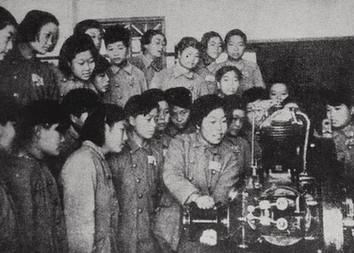| Wearing History -- Chinese Dress Since 1949
By XIN XIN
China has become the world's largest manufacturer andconsumer of clothing. Large cities not only feature variousdomestic and overseas famous brand franchise stores, but also countless stands selling low-cost clothes
WHEN the People's Republic of China was established, China's intelligentsia was fond of both Western-style suits and Chinese-style robes. Cheongsams were particularly popular among women.
Traditional Styles began to Change
As new China's ideology changed, Western-style suits and traditional clothes gradually faded from the mainstream. Instead, people imitated cadres' uniforms. Chairman Mao Zedong's favorite suit, known in the West as a "Mao suit," but actually designed and first worn by Sun Yat-sen, also became popular among common people. The outfit evolved into the single breasted "People's Suit," featuring sharp lapels and slanting pockets. Blue, grey and black were the colors of choice.
In the 1950s and early 60s, China was deeply influenced by the Soviet Union, even in clothing styles. The "Lenin Coat," featuring double lines of buttons, slanting pockets and a belt, came into vogue. In the meantime, people were keen on shirts based on the Soviet tank-crew uniform. In this period, most Chinese women liked to wear platye (a Russian word referring to a woman's button-up dress). The Soviet female experts working in China and heroines in Soviet literature often wore platyes, featuring round-collars, loose short sleeves, pleated hemlines and a belt. The design was well received among the Chinese female intelligentsia. Platyes were often made from cotton and were printed with dense flower, tartan or striped patterns. China used to import large quantities of patterned fabric and called for people to purchase it. At that time, even pedicab drivers wore cotton print.
 |
|
The "Lenin Coat" came into vogue in China in the 1950s. |
During this period clothes were also influenced by other socialist countries. For example, a kind of sweater from Albania was quite popular in China.
Money was very tight, so clothes were generally simple and unadorned. Being a tailor was an enviable job, since most people had their clothes hand made. Girls who were good at needlework always had a host of admirers chasing after them. The ability to repair old clothing was one of the criteria by which good tailors were judged.
From 1954 to 1983 people had to buy clothing with coupons in China. Especially in the late 1950s and early 60s, everything had to be purchased with coupons. The average city person could only afford three or four meters of cloth a year. As a result, people could only add new clothes during Spring Festival. Parents usually chose a bigger size when buying clothes for children so they would grow into them. It was common to pass down a coat from the older brothers and sisters to the younger siblings. People usually chose solid materials and black, blue and gray colors, so the clothes would last.
Cloth and military shoes were common. But military uniforms at this point were rare, since being a soldier was traditionally regarded as not a good job.
| 